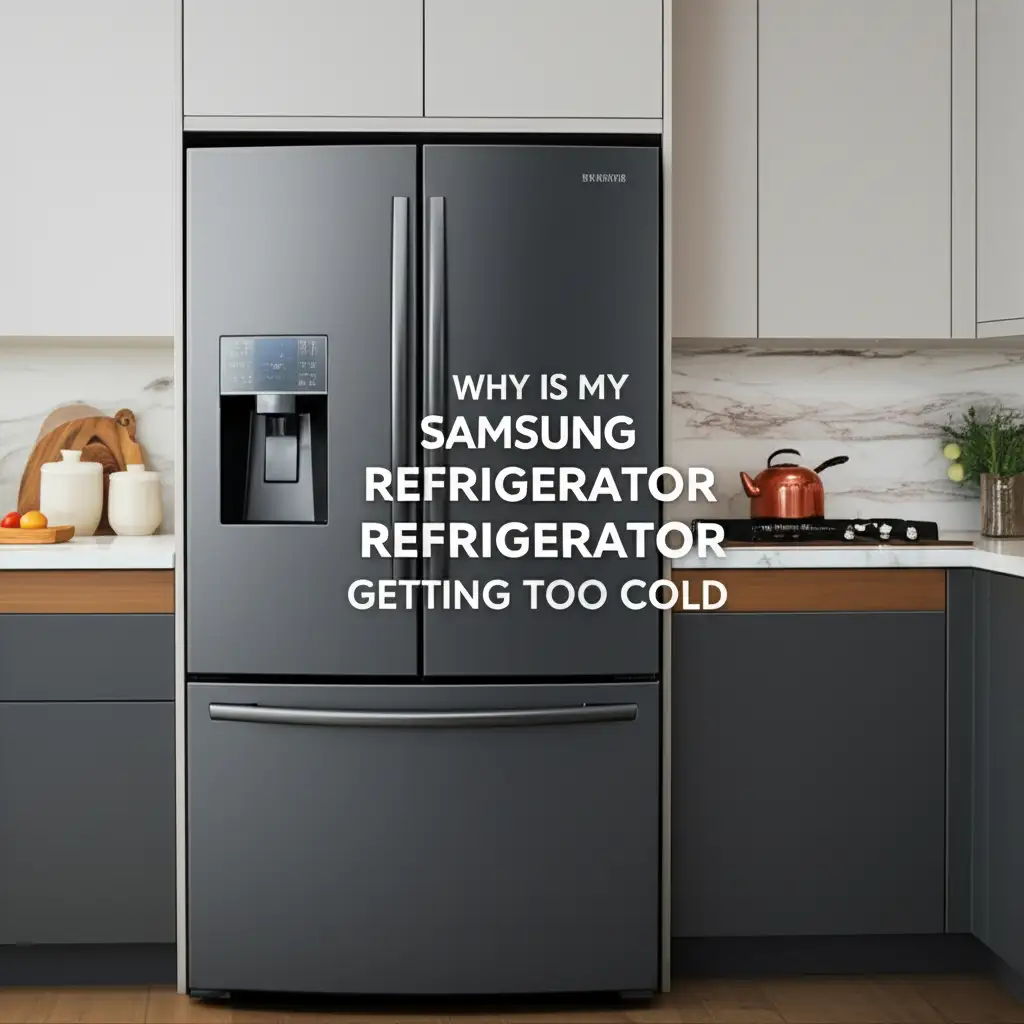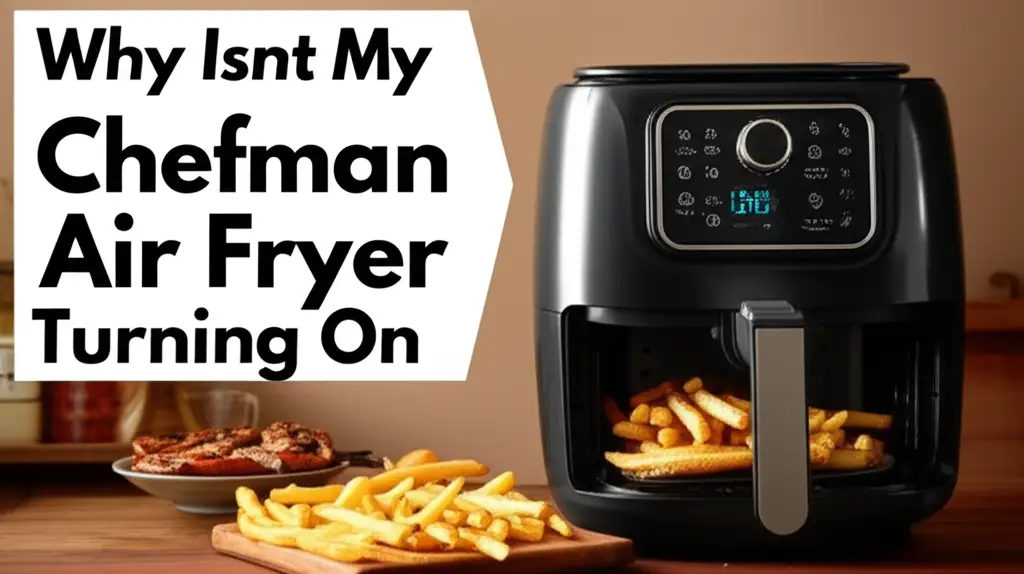· Katria Melrose · Home Appliance Troubleshooting · 20 min read
Why Is My Samsung Refrigerator Getting Too Cold

Troubleshooting Your Samsung Refrigerator: Why It’s Too Cold
Imagine opening your Samsung refrigerator and finding your fresh lettuce frozen solid. Your milk is icy, and the produce drawer feels more like a freezer. This problem, where your Samsung refrigerator is getting too cold, is a common issue. It can ruin food, waste energy, and become a huge frustration. I understand this problem well. Nobody wants to throw away perfectly good groceries because they froze unexpectedly.
This guide will help you understand why your Samsung refrigerator might be turning into an icebox. We will explore common culprits, from incorrect temperature settings to malfunctioning components. You will learn practical steps to diagnose the issue yourself. We will also cover straightforward solutions you can try at home. Let’s work together to restore your refrigerator to its proper cooling function. Your food deserves to stay fresh, not frozen.
Takeaway
- Check Settings First: Confirm your temperature settings are correct.
- Inspect Door Seals: Ensure seals are tight to prevent warm air entry and excess cooling.
- Clear Air Vents: Make sure food or items do not block internal air vents.
- Test Sensors and Dampers: A faulty temperature sensor or stuck damper causes overcooling.
- Consider Professional Help: If DIY fixes fail, a technician can diagnose complex issues.
Why is my Samsung refrigerator getting too cold?
Your Samsung refrigerator might be getting too cold due due to incorrect temperature settings, a faulty temperature sensor, a malfunctioning damper control, or a main control board issue. Food items blocking air vents or compromised door seals can also contribute to overcooling. Addressing these common problems often resolves the issue.
Adjusting Temperature Settings for Optimal Cooling
Many times, a Samsung refrigerator getting too cold starts with simple temperature settings. It is easy to accidentally change the settings. Perhaps a child played with the panel or you pressed the wrong button. This can cause the fridge to work harder than necessary. Always confirm your set temperature is correct for a refrigerator.
Most refrigerators should be set between 35 and 38 degrees Fahrenheit (1.7 to 3.3 degrees Celsius). A freezer should be set at 0 degrees Fahrenheit (-18 degrees Celsius). If your refrigerator is set lower than 35°F, it may freeze food items. Check your control panel, usually located on the front of the door or inside the refrigerator compartment. You may need to press a “Fridge” or “Temp” button to cycle through settings.
Some Samsung models feature dual temperature zones. This allows you to set different temperatures for the fresh food compartment and the freezer. Ensure both zones are set correctly. If you recently changed the settings, give the refrigerator 24 hours to stabilize. The internal temperature does not change instantly. Patience is key when adjusting.
Sometimes, the display might show Celsius when you expect Fahrenheit. This can confuse users. If your display reads “C” and you are used to “F”, you might set a much colder temperature than intended. For example, 0 degrees Celsius is freezing. You can learn how to change Samsung refrigerator from C to F if this is the case. Ensuring the correct unit of measurement is vital for accurate temperature control.
Your refrigerator works best with stable settings. Avoid constantly changing them. If the current setting is too low, raise it by a degree or two at a time. Then wait to observe the results. This approach helps you find the perfect balance without overshooting.
Inspecting and Cleaning the Damper Control Assembly
The damper control assembly plays a critical role in your Samsung refrigerator’s temperature regulation. It controls the flow of cold air from the freezer compartment into the fresh food section. Think of it as a gate that opens and closes. When this gate gets stuck open, too much cold air enters the refrigerator side. This causes the fresh food compartment to become excessively cold, often freezing contents.
A damper assembly can malfunction for several reasons. Ice buildup is a common culprit. If moisture gets into the damper mechanism, it can freeze and prevent the damper from closing properly. Dust and debris can also accumulate, jamming the moving parts. Sometimes, the damper motor itself fails, leaving the gate in an open position.
To inspect the damper, first locate it. It is typically found inside the fresh food compartment, often behind a panel near the top or back. You may need to remove shelves or bins to access it. Consult your Samsung refrigerator’s user manual for its exact location. Once you locate it, visually inspect it for signs of ice or obstruction. Use a flashlight if needed.
If you see ice, you can try defrosting the refrigerator. Unplug the unit and leave the doors open for several hours, or even overnight. Place towels on the floor to catch melting ice. This allows any ice around the damper to melt. After defrosting, plug the refrigerator back in and monitor its temperature. If the problem returns quickly, the issue might be deeper.
If the damper appears clear but remains stuck, it may require replacement. Before replacing, try to manually move the damper. It should open and close smoothly. If it feels stiff or does not move, it likely needs attention. You might be wondering why your GE refrigerator is warm but the freezer is cold. This indicates a similar problem with airflow, though it is the opposite symptom. The principles of air distribution are crucial for both issues.
Proper function of the damper ensures balanced cooling. A malfunctioning damper can lead to serious food spoilage. It also wastes energy as the compressor works overtime. Regularly checking for obstructions can prevent future problems.
Addressing a Faulty Temperature Sensor (Thermistor)
Your Samsung refrigerator relies on temperature sensors, also known as thermistors, to monitor the internal temperature. These small but vital components send readings to the main control board. The control board uses this information to determine when to activate the compressor and fans. If a thermistor fails or provides inaccurate readings, the refrigerator’s cooling cycle can go awry. For example, if a faulty sensor tells the control board the fridge is too warm, even if it’s already cold, the compressor will continue running. This leads to your Samsung refrigerator getting too cold and freezing items.
Thermistors can fail in various ways. They might register a resistance value that is too high or too low, indicating an incorrect temperature. They can also short circuit or go open circuit, sending no reading at all. When this happens, the control board receives bad data. It then makes poor decisions about cooling. You might notice your refrigerator runs almost constantly, or it cycles on and off at unusual intervals.
Locating the thermistor often requires some disassembly. In Samsung refrigerators, there are usually multiple thermistors. One is in the fresh food compartment, another in the freezer. They are typically clipped to an evaporator coil or placed in the air stream. Consult your service manual for exact locations. You will need a multimeter to test a thermistor. Disconnect the refrigerator from power before performing any tests.
To test the thermistor, disconnect its wire harness. Set your multimeter to read ohms (resistance). Touch the multimeter probes to the thermistor’s terminals. Compare the reading to a temperature-resistance chart for your specific thermistor model. These charts are often found in service manuals. As the thermistor’s temperature decreases, its resistance should increase. If the reading is far off, or if it reads open circuit (infinite resistance) or short circuit (zero resistance), the thermistor is faulty.
Replacing a faulty thermistor is a relatively straightforward repair for someone with basic appliance knowledge. You usually just unplug the old one and plug in a new one. This part is not usually expensive. However, accurate diagnosis is crucial. Sometimes, a faulty control board misinterprets good thermistor readings. This is less common but possible. If replacing the thermistor does not fix the problem, you may need to consider other components. Even if your fridge is not getting cold enough, like why your Kenmore refrigerator is not cold enough, sensor issues can contribute to cooling imbalances.
Examining Door Seals and Gaskets for Leaks
Door seals, or gaskets, are crucial for maintaining the proper temperature inside your Samsung refrigerator. These flexible rubber or magnetic strips create an airtight seal when the door is closed. This seal keeps warm room air out and cold refrigerator air in. If the door seals are damaged, cracked, or loose, warm, humid air can seep into the refrigerator compartment. This constant influx of warm air causes the compressor to run more frequently and for longer periods to maintain the set temperature. This excessive operation can inadvertently lead to the refrigerator getting too cold in some areas, as the system overcompensates.
A compromised seal also leads to increased energy consumption. The refrigerator works harder than necessary. This not only hikes up your utility bills but also puts extra strain on components. Eventually, this can shorten the lifespan of your appliance. A common symptom of a bad seal is condensation or frost buildup around the door frame. You might also notice the refrigerator always feels warm on the outside, even near the seals.
You can easily test your door seals. The “dollar bill test” is a simple method. Close the refrigerator door on a dollar bill. Try to pull the bill out. If it slides out easily, the seal in that spot is weak. Repeat this test all around the door. Pay close attention to corners and areas where you frequently open the door. You might also perform a visual inspection. Look for cracks, tears, or areas where the gasket has pulled away from the door.
Cleaning the gaskets regularly is also important. Food spills, dirt, and grime can accumulate on the seals. This prevents them from forming a tight seal. Use a mild soap and warm water to wipe them down. Dry them thoroughly afterward. If the gaskets are stiff or no longer sealing properly, they may need replacement. You can often purchase replacement gaskets directly from Samsung or an appliance parts supplier.
Replacing door seals is usually a DIY task. You often just pull the old one out of a channel and press the new one in. Make sure the new gasket fits snugly. After replacement, re-do the dollar bill test to confirm a tight seal. A tight seal ensures your refrigerator maintains its temperature efficiently. This prevents both too-warm and too-cold conditions. Proper sealing is fundamental to efficient refrigerator operation. Even a small gap can lead to significant cooling problems.
Optimizing Refrigerator Placement and Food Storage
The external environment and how you load your Samsung refrigerator significantly impact its internal temperature. Your refrigerator needs proper airflow around it. It also needs proper internal airflow. Placing the refrigerator too close to a wall or a heat source can disrupt its cooling efficiency. This can indirectly cause your Samsung refrigerator to get too cold. For example, if it’s near a hot oven, the compressor works harder. This extra work can lead to overcooling.
Refrigerator Placement:
- Clearance: Ensure there is adequate space around the refrigerator. Most manufacturers recommend at least 1-2 inches of clearance on the sides and back. The top also needs space for heat dissipation. This allows the condenser coils, typically located at the back or bottom, to release heat efficiently.
- Heat Sources: Avoid placing your refrigerator near direct sunlight, ovens, dishwashers, or heating vents. These heat sources force the refrigerator to run more often to compensate, potentially leading to overcooling. If unavoidable, try to insulate the area or move the heat source.
- Leveling: Ensure the refrigerator is level. Use a spirit level to check. Most refrigerators have adjustable feet at the bottom. A level refrigerator ensures the doors seal properly and the cooling system operates as intended.
Food Storage and Internal Airflow: Overfilling your refrigerator can block internal air vents. These vents distribute cold air evenly throughout the fresh food compartment. If air cannot circulate freely, some areas might become very cold, leading to freezing.
- Do Not Overpack: Leave space between items. Air needs to circulate around all your food. This helps maintain a consistent temperature throughout the compartment.
- Clear Air Vents: Identify the air vents inside your refrigerator. They are usually small grates on the back or sides. Make sure food containers, bags, or produce do not block these vents. This is vital for proper cold air distribution.
- Strategic Placement: Foods most susceptible to freezing (like leafy greens, eggs, and milk) should be stored away from the coldest spots. These spots are often near the back wall or directly beneath the freezer air outlet. The front of the shelves usually maintains a slightly warmer temperature.
Proper organization helps your refrigerator work smarter, not harder. A well-organized fridge reduces the time the door stays open. This keeps cold air inside. It also allows you to quickly find what you need. Understanding where the cold air comes from helps you place delicate items. This prevents them from freezing. For example, if your Samsung side-by-side refrigerator is not getting cold in one section, it could be due to blockages in its internal airflow system. This highlights how crucial airflow is for overall temperature balance. Taking these simple steps can prevent future freezing issues and extend the life of your appliance.
Troubleshooting a Malfunctioning Main Control Board
The main control board acts as the “brain” of your Samsung refrigerator. It receives signals from temperature sensors, processes user input from the control panel, and sends commands to various components. These components include the compressor, fans, and damper assembly. If the main control board malfunctions, it can send incorrect signals, causing the refrigerator to overcool. For instance, it might instruct the compressor to run continuously or incorrectly interpret sensor readings. This leads to your Samsung refrigerator getting too cold, freezing food inside.
Diagnosing a faulty control board can be challenging. It is often a last resort after ruling out simpler issues like sensor problems or damper failures. Signs of a failing control board are diverse. You might experience inconsistent temperatures, unusual cycling patterns, or even complete failure of some functions. The display panel might show error codes. It might also flicker or become unresponsive. If multiple components seem to be acting erratically, the control board could be the common denominator.
Before assuming the control board is bad, perform a basic reset. Disconnect your Samsung refrigerator from the power outlet for 5-10 minutes. Then, plug it back in. This can sometimes reset the board and clear minor glitches. If the problem persists, further investigation is needed. Unfortunately, testing a control board requires specialized knowledge and tools. It’s not something most homeowners can do safely or effectively.
A visual inspection of the control board might reveal obvious damage. Look for burn marks, swollen capacitors, or loose connections. These are clear indicators of a problem. However, many failures are internal and not visible. If you suspect the control board, it’s often best to consult a qualified appliance technician. They have diagnostic equipment to test the board’s functionality. They can also confirm if it needs replacement.
Replacing a main control board is generally an expensive repair. The part itself can be costly. Labor charges also add to the expense. For this reason, always exhaust all other diagnostic steps first. If your Samsung refrigerator is old, you might consider if replacing the board is cost-effective. Sometimes, the cost of repair approaches the cost of a new appliance. A professional can provide an accurate diagnosis and help you weigh your options. While issues like a Samsung oven blowing cold air or a Samsung dryer blowing cold air are different appliances, they highlight how a central control unit can impact system performance across various Samsung products.
Clearing a Clogged or Frozen Defrost Drain
A clogged or frozen defrost drain is another common reason your Samsung refrigerator might be getting too cold. Modern refrigerators have an automatic defrost system. This system periodically melts any ice that forms on the evaporator coils. The melted water then drains down a tube to a drain pan, where it evaporates. If this drain tube becomes clogged, the water cannot escape. It then accumulates and refreezes, often building up around the evaporator coils and the internal air pathways.
When ice builds up excessively, it can block the cold air return vent. This prevents warm air from reaching the evaporator for cooling. It can also block the cold air supply vent, leading to uneven cooling. Sometimes, the ice simply acts as an additional cooling element, causing the fresh food compartment to overcool. You might notice water puddles inside your refrigerator or on the floor under the unit. You might also see visible ice buildup on the back wall of the fresh food compartment, especially near the top.
To address this issue, you will need to access the defrost drain tube. This usually involves removing the back panel inside your freezer compartment. First, unplug your Samsung refrigerator from the power supply. Then, carefully remove any shelves, ice maker components, or other obstacles. You will see the evaporator coils and likely a drain trough beneath them. The drain tube typically extends from this trough.
Look for ice or debris blocking the drain hole or the tube itself. You can use a turkey baster or a syringe to flush the drain tube with warm water. This helps melt any ice and clear minor clogs. For stubborn clogs, you might need to use a small, flexible brush or a pipe cleaner to physically dislodge the blockage. Be gentle to avoid damaging the tube. Some people pour a mixture of baking soda and hot water down the drain to help clear organic clogs.
If the drain tube is frozen solid, you will need to manually defrost the unit. Unplug the refrigerator and leave the doors open for several hours, or even overnight. Place towels on the floor to absorb melting water. This complete defrost will melt all ice, including any in the drain tube. Once defrosted, clean the drain tube to prevent future clogs. You might also check the drain pan underneath the refrigerator. Ensure it is not overflowing and that the drain tube leads directly into it. Regular maintenance of this drain system is crucial for optimal refrigerator performance and temperature regulation.
When to Call a Professional Appliance Technician
While many Samsung refrigerator cooling issues can be resolved with DIY troubleshooting, there are times when calling a professional appliance technician is the best course of action. Knowing when to seek expert help can save you time, prevent further damage, and ensure your refrigerator is repaired safely and correctly. It is important to recognize your limitations. Some repairs require specialized tools, in-depth knowledge, or handling of refrigerants.
Consider calling a professional if:
- You cannot identify the problem: You have followed all the troubleshooting steps in this guide, but your Samsung refrigerator is still getting too cold. The issue might be more complex than a simple fix.
- The repair involves refrigerant: Refrigerant leaks or issues with the sealed system (compressor, evaporator, condenser) require certified technicians. Handling refrigerants without proper training and equipment is dangerous and illegal.
- You lack the necessary tools or expertise: Some repairs, like replacing a main control board or diagnosing compressor issues, demand specific diagnostic tools and technical knowledge. Attempting them without proper expertise can worsen the problem.
- There are electrical issues: If you suspect a wiring problem, short circuit, or power supply issue, do not attempt to fix it yourself. Electrical repairs are risky and should only be handled by a qualified professional.
- The problem is intermittent and baffling: If your refrigerator seems to work fine sometimes and then suddenly overcools, it might indicate an elusive electrical or control board glitch that a technician can pinpoint.
- Your refrigerator is still under warranty: If your Samsung refrigerator is still covered by its manufacturer’s warranty, attempting DIY repairs might void it. Check your warranty terms before starting any work. Contact Samsung service or an authorized repair center instead.
- Safety concerns arise: Anytime you feel unsafe performing a repair, or if there are sparks, strange smells, or excessive heat, immediately unplug the appliance and call a professional. Your safety is paramount.
A professional technician has the training and experience to accurately diagnose complex issues. They carry specialized tools and have access to service manuals and parts. They can quickly pinpoint the root cause of your Samsung refrigerator getting too cold. This saves you from trial-and-error replacements. While there is a cost involved, it often pays off in the long run. Professional repair ensures your appliance runs efficiently and reliably. They can also offer advice on preventing future issues.
Frequently Asked Questions
Why does my Samsung fridge freeze food in the deli drawer?
Food freezes in the deli drawer if it’s too close to the cold air vent, the temperature setting is too low, or the air damper is stuck open. The deli drawer is often the coldest spot in the fresh food section. Try raising the refrigerator temperature slightly. Also, check that items aren’t blocking the air vent leading to that drawer.
Can a full freezer cause my Samsung fridge to be too cold?
A very full freezer usually does not directly cause the fresh food section to be too cold. In fact, a fuller freezer generally runs more efficiently. However, if items in the freezer block the air return vent, it can disrupt proper airflow to the refrigerator. This might cause the refrigerator’s compressor to run more, leading to overcooling.
How do I reset my Samsung refrigerator’s temperature?
You can reset your Samsung refrigerator’s temperature by accessing the control panel on the door or inside. Press the “Fridge” or “Temp” button to cycle through temperature settings. For a hard reset, unplug the refrigerator from the wall outlet for 5-10 minutes, then plug it back in. This often clears minor electronic glitches.
What temperature should my Samsung fridge be set at?
Your Samsung refrigerator should ideally be set between 35°F (1.7°C) and 38°F (3.3°C). This range is safe for food storage and helps prevent bacterial growth while avoiding freezing. The freezer compartment should be set to 0°F (-18°C). Adjust settings gradually and allow 24 hours for the temperature to stabilize.
When should I call a technician for a Samsung fridge that’s too cold?
You should call a technician if you’ve tried common troubleshooting steps like adjusting settings, checking seals, and cleaning vents, but the issue persists. Also, call a professional if you suspect a faulty control board, refrigerant leak, or if the repair requires specialized tools or knowledge you don’t possess.
How does humidity affect my refrigerator’s temperature?
High humidity outside your refrigerator can cause the appliance to work harder. When humid air enters through poor door seals, the refrigerator needs to remove more moisture. This increased workload can sometimes lead to the compressor running longer, potentially causing your Samsung refrigerator to get too cold as it overcompensates. Ensure your door seals are intact to prevent this.
Conclusion
Finding your Samsung refrigerator getting too cold can be frustrating. Food freezing wastes money and time. However, many common causes have simple solutions. We have explored vital steps, from checking your temperature settings to inspecting the damper control assembly. We also covered the importance of a working temperature sensor and tight door seals. Understanding how your refrigerator’s placement and internal food storage impact its performance is also key.
Always start with the easiest fixes. Adjust the temperature, clear air vents, and test door seals. If these steps do not resolve the problem, then move to more involved diagnostics. Checking the temperature sensor or the defrost drain can often reveal the root cause. Remember, the main control board is usually a last resort for troubleshooting. If you find yourself in over your head, or if the repair involves complex components like refrigerants, do not hesitate to call a professional appliance technician. They possess the expertise and tools for safe and effective repairs.
By carefully following these steps, you can likely restore your Samsung refrigerator to its proper working condition. This ensures your food stays fresh, not frozen, and your appliance runs efficiently for years to come. Take action now to protect your groceries and optimize your refrigerator’s performance.
- Samsung refrigerator
- refrigerator repair
- fridge too cold
- appliance troubleshooting
- freezing food
- temperature control
- DIY fridge repair





